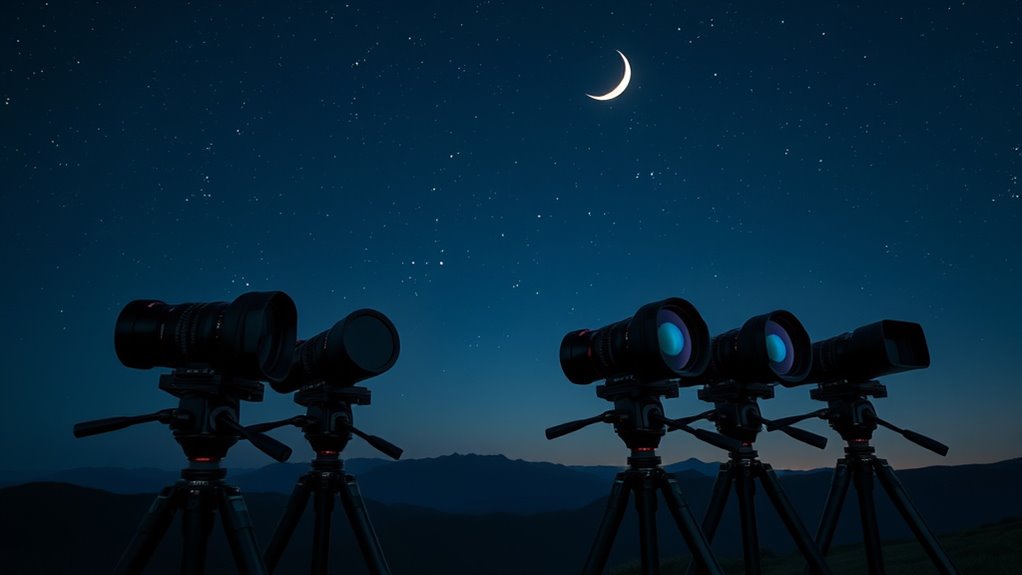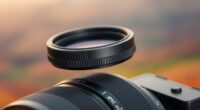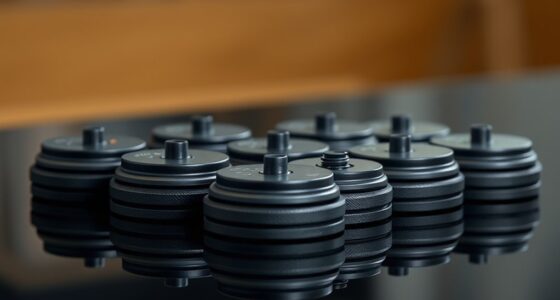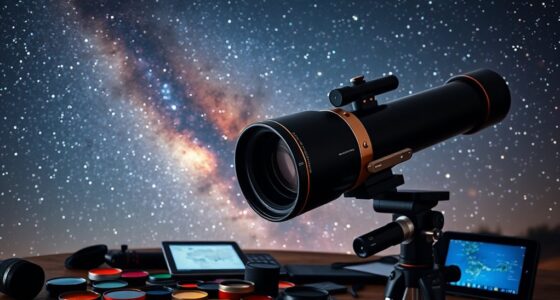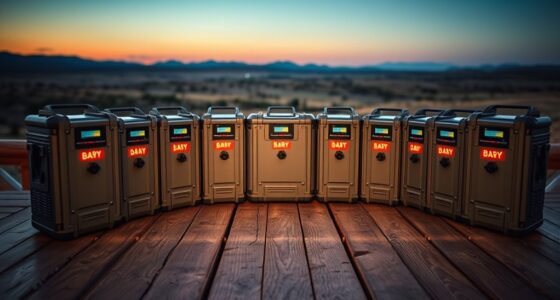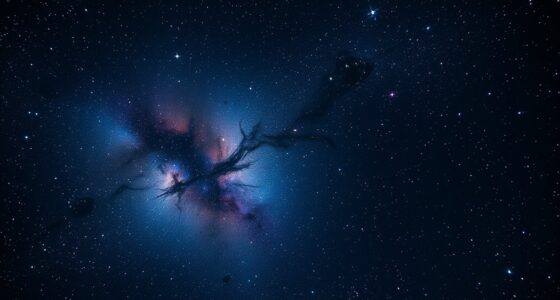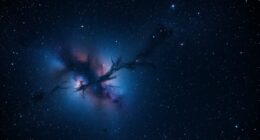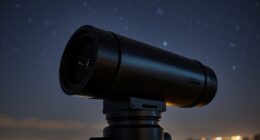If you’re aiming to capture stunning eclipse images in 2025, I recommend considering flagship CMOS cameras like the ZWO ASI183MC Pro with its 20.1 MP sensor, offering high resolution and excellent low-light performance. The SVBONY SV405CC with advanced TEC cooling guarantees cleaner images during long exposures. For versatile needs, the Celestron NexImage 5 and ZWO ASI120MM-Mini are reliable choices. Continue exploring options, and you’ll discover the top gear to make your eclipse photography truly exceptional.
Key Takeaways
- Prioritize cameras with high sensor resolution and sensitivity for capturing fine eclipse details.
- Choose models with TEC cooling and low noise for long exposures during eclipse imaging.
- Opt for versatile cameras compatible with popular astrophotography software and mount control systems.
- Consider portability, ease of setup, and durability for quick, reliable eclipse shots in field conditions.
- Select CMOS cameras with high frame rates and ROI support to optimize image quality and capture fleeting moments.
ZWO ASI183MC Pro 20.18 MP CMOS Astronomy Camera
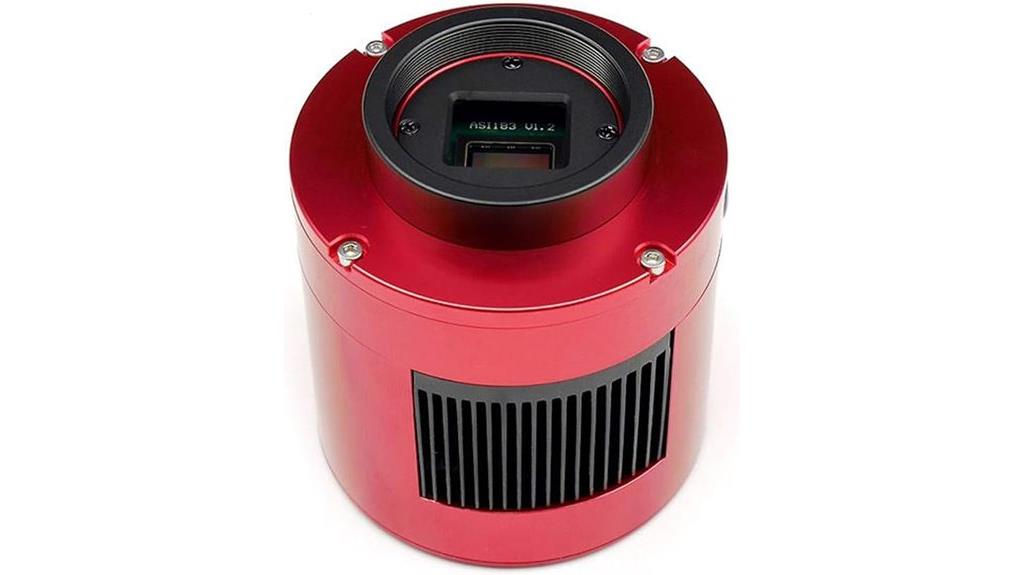
If you’re looking for a versatile and high-resolution CMOS camera for deep-sky, lunar, or solar imaging, the ZWO ASI183MC Pro is an excellent choice. It boasts a 20.1 MP CMOS sensor with 5496×3672 resolution and 2.4-micron pixels, capturing incredible detail. The TEC cooling system reduces noise by lowering sensor temperatures markedly below ambient, perfect for faint object imaging. Its USB 3.0 connection supports fast data transfer, while its compact aluminum body fits 1.25” and 2” focusers. Ideal for astrophotography and EAA, it produces sharp, colorful images without filters, especially when paired with quality telescopes and mounts.
Best For: amateur astronomers and astrophotographers seeking a high-resolution, versatile CMOS camera for deep-sky, lunar, and solar imaging with excellent detail and low noise.
Pros:
- High-resolution 20.1 MP CMOS sensor captures fine details of astronomical objects
- TEC cooling system effectively reduces sensor noise during long exposures
- Compact, lightweight design with versatile compatibility for 1.25” and 2” focusers
Cons:
- Older model compared to newer cameras with larger pixels or more advanced features
- Requires a separate 12V power supply for the TEC cooler, adding setup complexity
- Calibration needed to address amp glow and noise, particularly in long-exposure deep-sky imaging
SVBONY SV105 Telescope Camera for Astrophotography
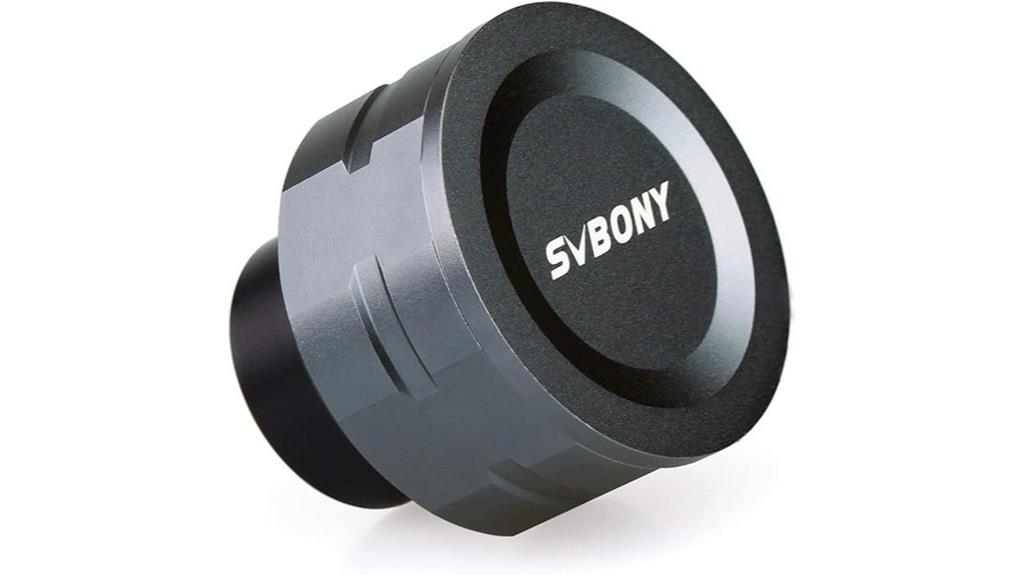
Looking for an affordable, user-friendly astrophotography camera perfect for beginners? The SVBONY SV105 Telescope Camera is a great choice. It features a 1/2.8 IMX307 CMOS sensor, capturing crisp 1080p videos at 30 fps, ideal for lunar and planetary imaging. Its 1.25-inch threaded interface works seamlessly with telescope filters, and it connects directly without needing drivers—just plug in and go. Compatible with Windows, Linux, Android, and macOS, it supports popular software like SharpCap. Weighing just 9.6 ounces, it’s portable and simple to set up, making it perfect for newcomers enthusiastic to explore astrophotography without breaking the bank.
Best For: beginners and amateur astronomers seeking an affordable, easy-to-use camera for lunar and planetary astrophotography.
Pros:
- Plug-and-play connection with no driver installation required
- Compatible with multiple operating systems including Windows, Linux, Android, and macOS (macOS only)
- Lightweight and portable design ideal for beginners and casual observers
Cons:
- Moderate noise levels and potential hardware compatibility issues for some users
- Limited to 1080p resolution, less suitable for deep-sky or high-resolution imaging
- Not designed for professional or advanced astrophotography needs, such as low-light deep-sky imaging
Celestron NexImage 5 Solar System Imager
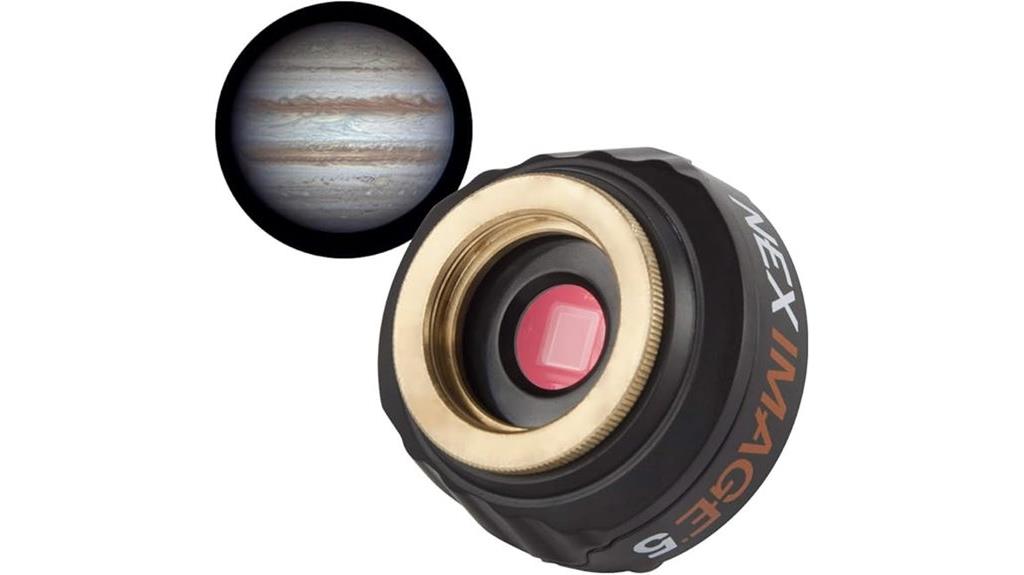
The Celestron NexImage 5 Solar System Imager stands out as an excellent choice for beginners seeking an easy-to-use astrophotography camera that delivers high-resolution images. Its 5 MP CMOS sensor captures detailed color photos of the Moon, planets, and Sun with clarity, even in less-than-ideal conditions. The camera supports native 2592 x 1944 resolution, has low noise, and accepts standard filters through its 1.25-inch barrel. With features like live preview, frame stacking, and adjustable exposure, it’s versatile and straightforward to operate. Compatible with most telescopes, it’s perfect for newcomers wanting quality images without complex setup. Just remember to update drivers for the best experience.
Best For: beginners and amateur astronomers seeking an easy-to-use, high-resolution astrophotography camera for capturing detailed images of the Moon, planets, and Sun.
Pros:
- User-friendly and easy to set up, ideal for newcomers.
- High-resolution 5 MP CMOS sensor captures detailed color images.
- Compatible with most telescopes and supports standard filters and accessories.
Cons:
- Requires software updates and driver downloads for optimal performance.
- Image quality can be affected by environmental conditions and setup accuracy.
- Some users experience issues with outdated bundled software and limited advanced features.
ZWO ASI120MM-Mini Monochrome Astronomy Camera

The ZWO ASI120MM-Mini Monochrome Astronomy Camera stands out as an ideal choice for planetary imaging and autoguiding, especially for amateur astronomers seeking a compact and lightweight device. Its 1/3” CMOS sensor delivers sharp images with 1280×960 resolution and 3.75-micron pixels, while the 75% QE guarantees excellent light sensitivity. Weighing just 2.1 ounces and fitting into a 1.25” focuser, it’s highly portable and easy to integrate with most telescopes. With USB 2.0 Type-C connectivity and an ST4 port for autoguiding, plus included software, this camera offers excellent performance for eclipse photography and beyond.
Best For: amateur astronomers and astrophotographers seeking a compact, lightweight monochrome camera for planetary imaging and autoguiding.
Pros:
- Compact and lightweight design easily fits into 1.25” focuser, enhancing portability.
- High sensitivity with 75% QE and low read noise for clear, detailed images.
- USB 2.0 Type-C interface ensures fast and reliable connectivity with modern devices.
Cons:
- Limited resolution of 1280×960 may not be suitable for high-resolution deep-sky imaging.
- Monochrome only; requires filters for color imaging.
- Software and driver support may require updates or troubleshooting for some systems.
SVBONY SV405CC Cooled Camera, 11.7 MP CMOS Deep Sky Camera
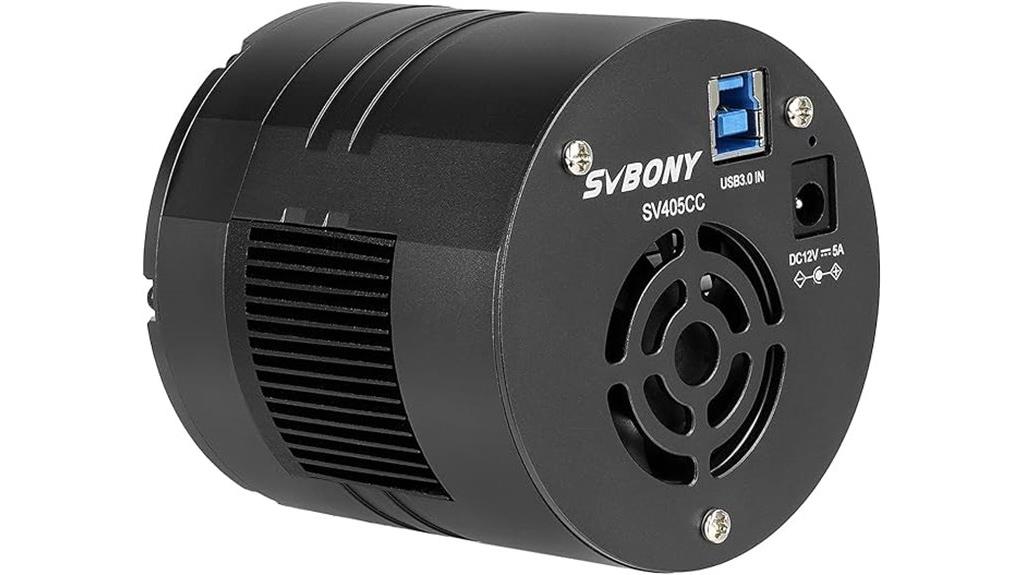
If you’re seeking an affordable yet capable deep sky camera, the SVBONY SV405CC stands out with its 11.7 MP CMOS sensor and effective cooling system. Its IMX294 sensor offers a wide field of view and true 4K output at 120 fps, ideal for capturing nebulae, galaxies, and star clusters. The two-stage TEC cooling reduces sensor temperature by 86°F below ambient, minimizing noise during long exposures. Compatible with multiple OS and software like SharpCap, N.I.N.A., and TheSkyX, it’s versatile, though some users report software setup challenges. Overall, it’s a solid budget option delivering good image quality for deep-sky and lunar photography.
Best For: amateur astronomers and astrophotographers seeking an affordable, versatile deep sky camera capable of high-resolution imaging and effective cooling.
Pros:
- High-resolution 11.7 MP CMOS sensor with true 4K output at 120 fps for detailed astrophotography.
- Effective two-stage TEC cooling system reduces sensor temperature by 86°F below ambient, minimizing noise during long exposures.
- Wide compatibility with multiple operating systems and software including SharpCap, N.I.N.A., and TheSkyX, offering versatile usage options.
Cons:
- Some users experience software setup challenges, including delays and buffer issues affecting image acquisition and plate solving.
- Cooling fan failures reported after limited use can increase sensor noise and impact image quality.
- Potential difficulties with physical handling, such as dust or fingerprints on the sensor during transit, requiring careful cleaning.
SVBONY SV205 Astrophotography Camera with IMX415 Sensor

For amateur astronomers seeking an easy-to-use, plug-and-play camera, the SVBONY SV205 with IMX415 sensor stands out as a reliable option. It features a 7.05MP CMOS sensor that captures sharp, detailed images of planets, the Moon, and stars. With USB 3.0 connectivity and no driver installation needed, it offers real-time viewing and recording. Its compact size and lightweight design make it versatile for various telescopes. The camera supports high-quality video recording at 30FPS in 1080p and features dark light compensation to improve low-light images. Overall, it’s a user-friendly choice for those starting in astrophotography or eclipse photography.
Best For: amateur astronomers and beginner astrophotographers seeking an easy-to-use, plug-and-play camera for capturing detailed images of celestial objects and terrestrial targets.
Pros:
- Plug-and-play operation with no driver installation required, ideal for beginners
- High-resolution 7.05MP CMOS sensor delivers sharp, detailed images of planets, the Moon, and stars
- Supports high-quality video recording at 30FPS in 1080p, perfect for real-time observation and sharing
Cons:
- Customer ratings suggest some users may experience limited software or connectivity issues
- Limited advanced features for professional astrophotography or deep-sky imaging
- Slightly bulky for ultra-portable setups compared to smaller, specialized astrophotography cameras
SVBONY SV305C Pro Telescope Camera
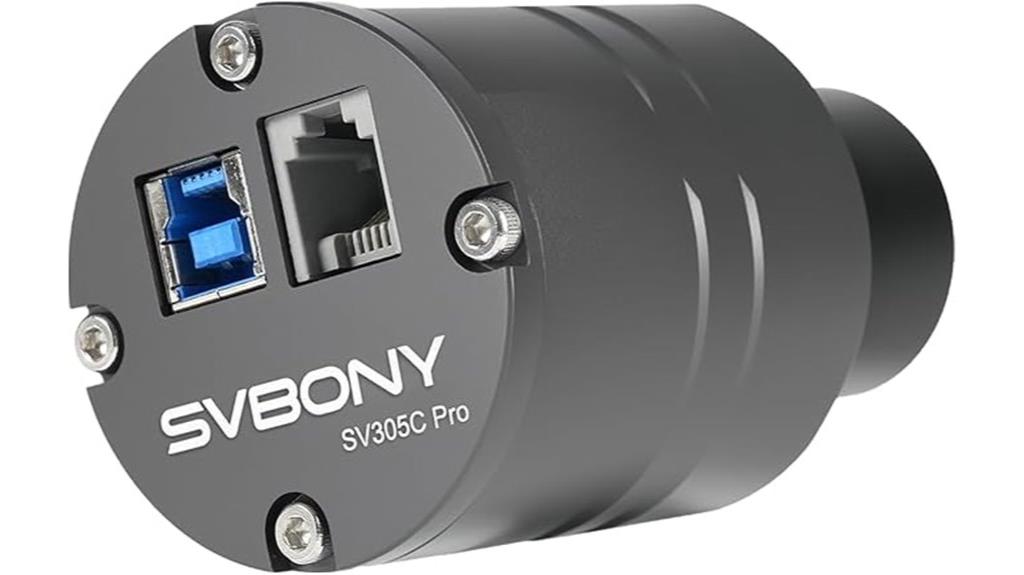
Are you looking for a planetary camera that combines ultra-high sensitivity with low noise? The SVBONY SV305C Pro is perfect for capturing stunning planetary details, even in low light. Its IMX662 sensor offers ultra-low readout noise of just 0.7e-, resulting in clearer, sharper images. With HDR capabilities, it handles fast-moving targets smoothly, producing vibrant, detailed shots without chromatic aberration. The 1920×1080 resolution at 107FPS ensures ultra-smooth footage of planets like Jupiter and Saturn. Plus, its USB 3.0 transfer speeds streamline your workflow, while the design’s heat dissipation keeps images consistent during long sessions.
Best For: amateur astronomers and astrophotographers seeking high-quality planetary imaging with minimal noise and fast data transfer.
Pros:
- Ultra-high sensitivity with ultra-low readout noise of only 0.7e- for clearer, sharper images
- High frame rate of 107FPS and 1920×1080 resolution ensures smooth, detailed footage of fast-moving planets
- USB 3.0 transfer speeds streamline workflow and reduce data transfer time
Cons:
- Limited to planetary and fast-moving target imaging, not ideal for deep-sky astrophotography
- May require compatible software and additional accessories for full tracking and guiding setup
- Compact design might limit customization options for advanced imaging setups
Celestron NexImage 20 Solar System Camera
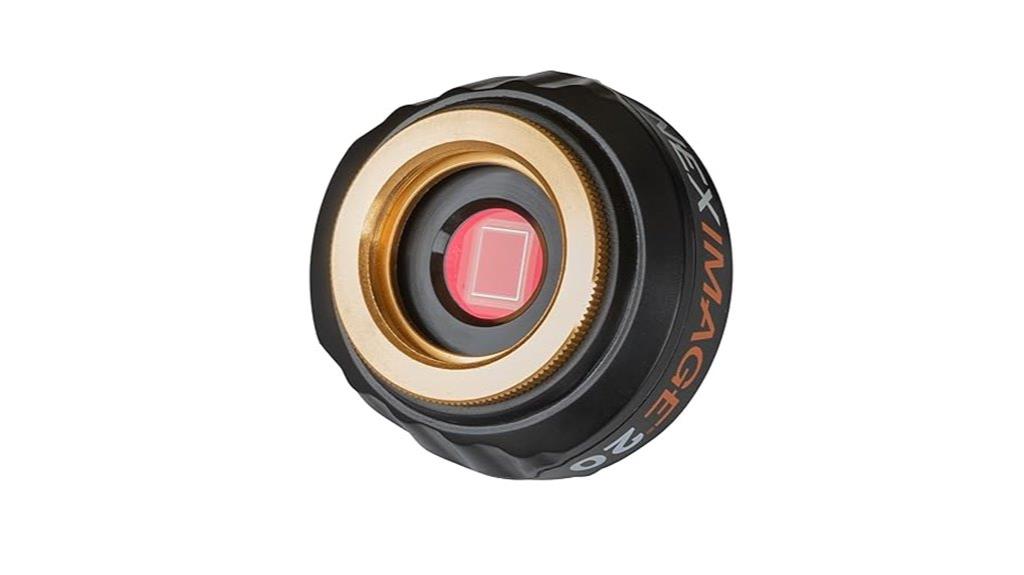
The Celestron NexImage 20 Solar System Camera stands out with its high-resolution 20 MP CMOS sensor, making it an excellent choice for astrophotographers aiming to capture detailed images of the Moon, planets, and Sun. Its 5240 x 3840 resolution and 1.4-micron pixels deliver crisp, fine details even under average seeing conditions. The camera connects via USB-C for fast data transfer and fits standard focusers with its 1.25-inch nosepiece. Featuring user-friendly software and ROI support, it allows quick setup and versatile imaging, including autoguiding for long exposures. Overall, it’s a compact, powerful tool for serious Solar System imaging.
Best For: amateur and professional astrophotographers seeking high-resolution planetary and Solar System imaging with versatile features including autoguiding and quick setup.
Pros:
- High-resolution 20 MP CMOS sensor captures detailed lunar, planetary, and solar images.
- Supports Region of Interest (ROI) for faster frame rates and easier image stacking.
- Includes user-friendly iCap software and built-in autoguiding capabilities for advanced astrophotography.
Cons:
- Primarily designed for Solar System objects; less suitable for deep-sky astrophotography without additional equipment.
- May require compatible telescopes with 1.25-inch focusers for optimal use.
- High-resolution images demand substantial storage and processing power for best results.
ZWO ASI174MM-MINI Monochrome Astronomy Camera
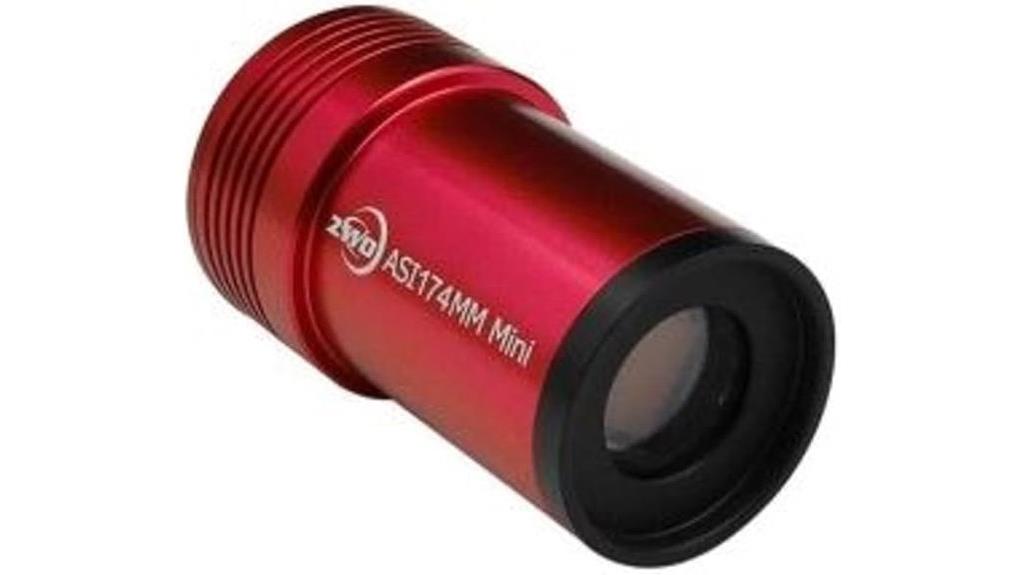
Looking for a compact, reliable guide camera that excels in long exposure astrophotography and planetary imaging? The ZWO ASI174MM-MINI fits the bill perfectly. Its 2.3-megapixel CMOS sensor, with high QE and low noise, detects faint guide stars over a broad field of view, especially useful with longer focal length telescopes. Weighing just 4.9 ounces and fitting into a 1.25-inch focuser, it’s easy to mount and operate. With USB2.0 data transfer and ST4 guiding port, it integrates seamlessly into existing setups. Plus, its durable CNC aluminum body guarantees longevity, making it a trusted choice for serious astrophotographers.
Best For: astrophotographers seeking a compact, reliable guide camera for long exposure imaging and planetary observation with long focal length telescopes.
Pros:
- High quantum efficiency and low noise for detecting faint guide stars
- Lightweight and compact, fitting into a 1.25-inch focuser for easy mounting
- Durable CNC aluminum construction ensures longevity and stable performance
Cons:
- Limited to monochrome imaging; requires filters for color observation
- USB2.0 interface may restrict maximum data transfer speed compared to newer standards
- Does not include a solar filter, so solar imaging requires additional accessories
ZWO ASI174MM 2.3 MP CMOS Monochrome Astronomy Camera with USB 3.0# ASI174MM
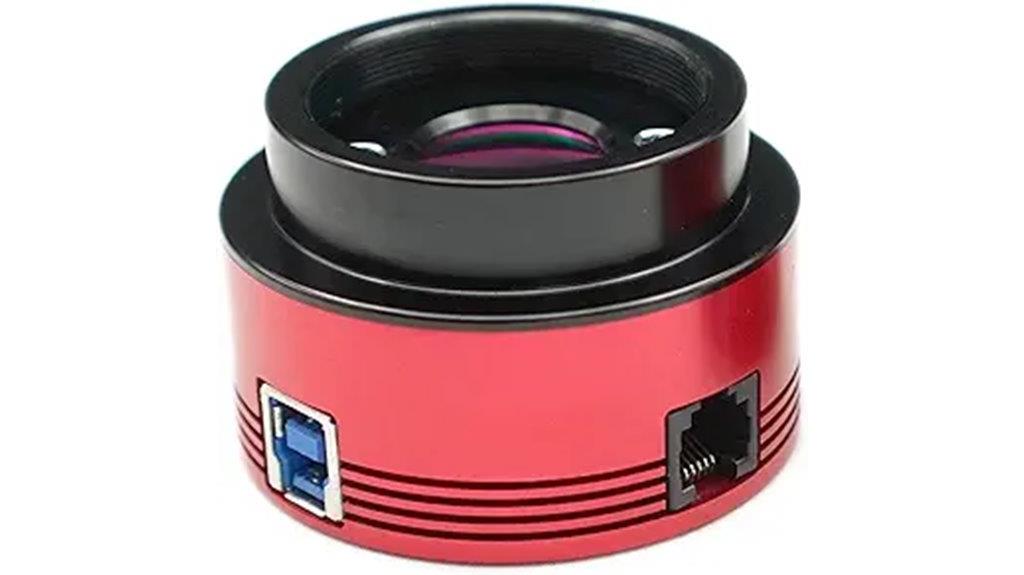
For astronomers seeking high-resolution, monochrome imaging of celestial objects, the ZWO ASI174MM stands out with its advanced 11.3mm x 7.1mm CMOS sensor and 1936×1216 resolution. This camera captures fine detail on the Moon, planets, and deep-sky objects, making it ideal for astrophotography. It supports USB 3.0, allowing rapid data transfer of up to 164 frames per second at full resolution. Its compact, durable design connects easily to 1.25-inch focusers. Compatible with Mac and Windows, it’s versatile for various setups. Plus, it can produce color images using optional filters and standard processing, enhancing imaging flexibility.
Best For: amateur and professional astronomers seeking high-resolution monochrome imaging of celestial objects such as the Moon, planets, and deep-sky targets with fast data transfer and versatile compatibility.
Pros:
- High-resolution 1936×1216 CMOS sensor captures fine astronomical details
- Supports USB 3.0 for rapid data transfer up to 164 fps at full resolution
- Compact, durable design with compatibility for Mac and Windows systems
Cons:
- Monochrome sensor requires additional filters for color imaging
- Not included, and necessary filters must be purchased separately for color photography
- May require a steep learning curve for beginners unfamiliar with astrophotography setup
ZWO Seestar S50 Smart Digital Telescope
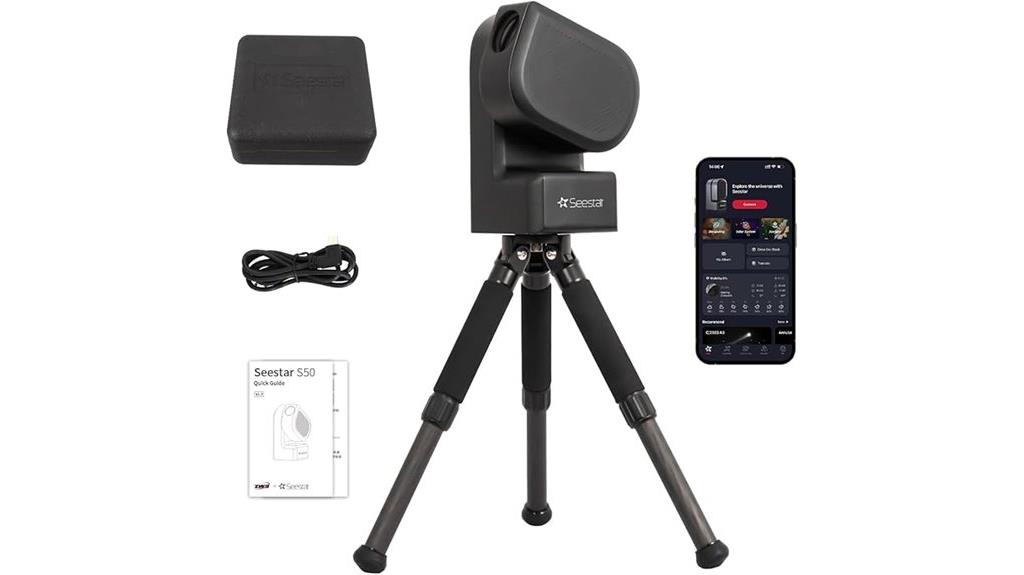
If you want a portable, easy-to-use astrophotography setup, the ZWO Seestar S50 Smart Digital Telescope stands out as an excellent choice. Weighing just 2.5kg, it’s a compact, all-in-one system that includes a telescope, electronic focuser, camera, ASIAIR, altazimuth mount, and dew heater. Its triplet apochromatic optics deliver sharp images with minimal chromatic aberration, perfect for deep-sky objects. With wireless Bluetooth and Wi-Fi, controlling it is simple via the intuitive app. Setup is straightforward—just level the tripod, attach the device, and start observing. Its portability makes it ideal for travel, hiking, and quick astrophotography sessions.
Best For: beginners, amateur astronomers, and travelers seeking an easy-to-use, portable astrophotography solution.
Pros:
- Lightweight and compact design weighing only 2.5kg for excellent portability
- Fully integrated all-in-one system with automated features and intuitive app control
- High-quality triplet apochromatic optics provide crisp images with minimal chromatic aberration
Cons:
- Smaller aperture may limit planetary detail outside the Moon
- Limited advanced customization options compared to larger, professional telescopes
- May require a stable Wi-Fi or Bluetooth connection for optimal operation
SVBONY SC311 WiFi Telescope Camera Eyepiece
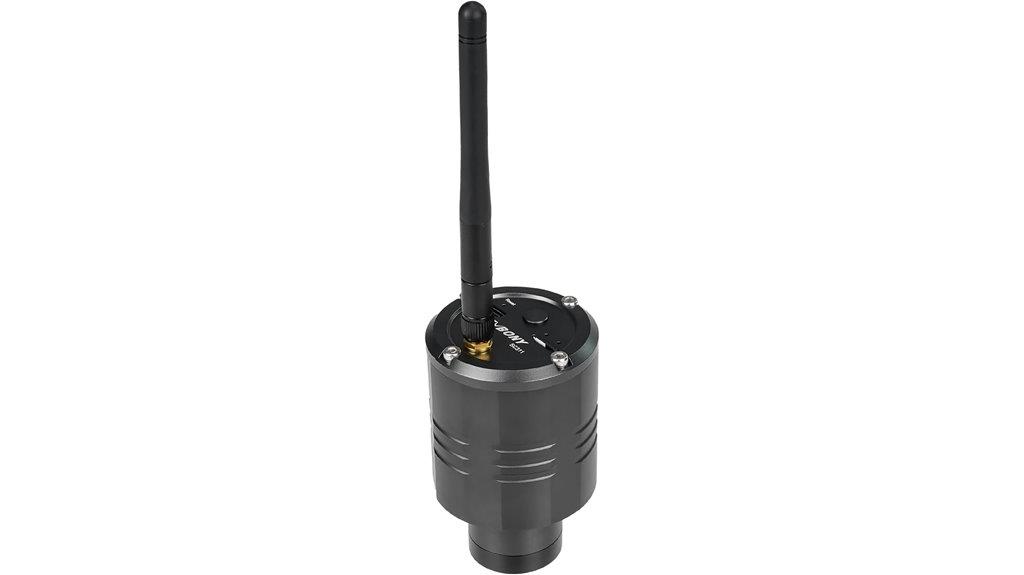
The SVBONY SC311 WiFi Telescope Camera Eyepiece stands out as an excellent choice for amateur astronomers seeking easy social sharing and versatile imaging capabilities. Its IMX662 CMOS sensor captures 1080P planetary images, making it perfect for Moon photography. While it requires pairing with a telescope, it’s compatible with SvbonyAstro software, allowing you to stream and save images via your phone or tablet. With WiFi connectivity supporting up to four devices, multi-user sharing is simple. Its built-in battery lasts around four hours, and the included 32GB TF card provides ample storage. Overall, this camera offers a user-friendly way to enhance your astrophotography and share your celestial discoveries.
Best For: amateur astronomers and astrophotographers looking for an easy-to-share, versatile planetary imaging camera compatible with smartphones and tablets.
Pros:
- Supports 1080P planetary imaging, ideal for Moon photography.
- WiFi connectivity allows up to four devices for multi-user sharing.
- Long battery life of approximately four hours and expandable storage up to 256GB.
Cons:
- Requires pairing with a telescope; cannot operate independently.
- Limited to 1080P resolution; not suitable for high-definition astrophotography.
- Compatibility depends on SvbonyAstro software, which may have a learning curve for some users.
SVBONY SV605CC Cooled Camera, 9MP CMOS for Astronomy and Deep Sky Astrophotography
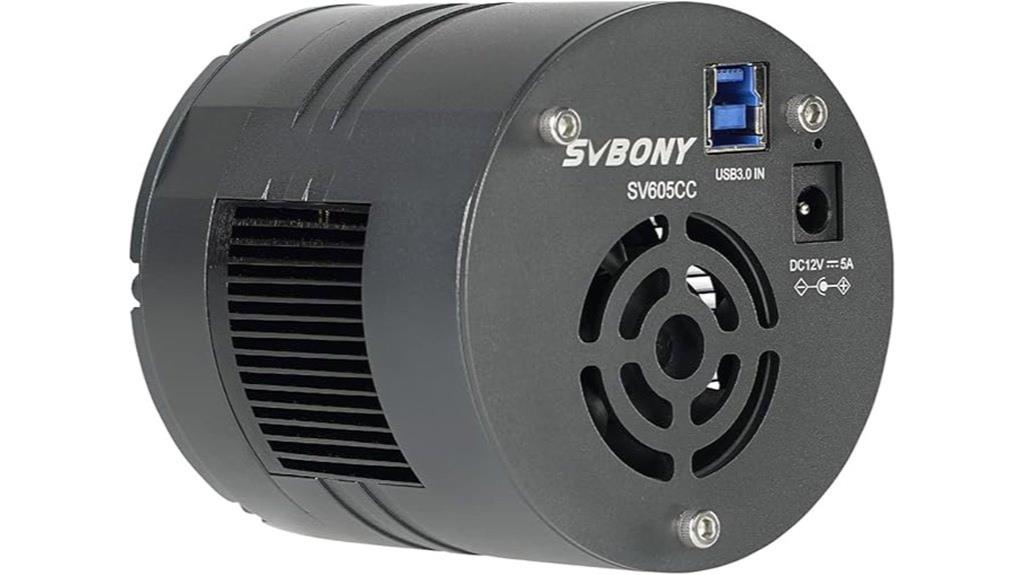
Stargazing enthusiasts and astrophotographers seeking high-quality deep sky images will find the SVBONY SV605CC Cooled Camera an excellent choice due to its advanced cooling technology and high-resolution CMOS sensor. Featuring a 9MP IMX533 chip, it captures detailed images with an 80% quantum efficiency and a wide 10-degree field of view. Its TEC cooling system reduces temperatures by up to 30°C below ambient, minimizing thermal noise during long exposures. Compatible with Windows, Linux, Mac OS, Chrome OS, and Raspberry Pi, it’s versatile for both indoor and outdoor use. Whether for deep-sky, meteor monitoring, or lucky imaging, this camera delivers clear, sharp, and vibrant astrophotos.
Best For: amateur and professional astronomers who want high-resolution deep sky imaging with advanced cooling technology for clear, detailed astrophotographs.
Pros:
- High 9MP resolution with IMX533 CMOS sensor for sharp, detailed images
- Effective TEC cooling system reduces thermal noise during long exposures
- Wide 10-degree field of view suitable for various astrophotography applications
Cons:
- Requires compatibility with multiple operating systems, which may involve setup complexity
- May need additional accessories or mounts for optimal use with telescopes
- The cooling system and high-resolution sensor can increase the overall cost of the setup
Factors to Consider When Choosing a Cmos Astro Camera for Eclipse
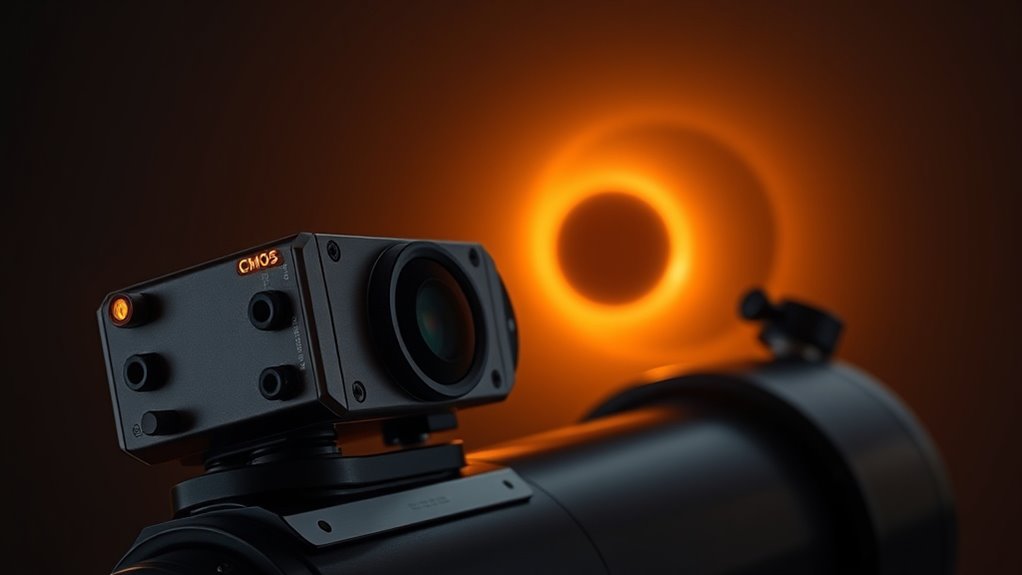
When selecting a CMOS astro camera for an eclipse, I focus on key factors that impact image quality and usability. Things like sensor sensitivity, cooling capabilities, and frame rate directly affect the clarity and detail I can capture. Understanding these aspects helps me choose a camera that best suits my eclipse photography needs.
Sensor Sensitivity & Resolution
Choosing the right CMOS astro camera for eclipse imaging hinges largely on sensor sensitivity and resolution. Higher sensitivity, or quantum efficiency, lets me capture faint eclipse details with less exposure time, resulting in clearer images. A sensor with higher resolution, meaning more pixels, produces sharper images that reveal fine features like prominences and surface textures. Combining enhanced sensitivity and resolution improves my ability to record subtle brightness variations and delicate structures during an eclipse. Larger pixel sizes generally offer better low-light performance, which is crucial for capturing dimmer features. However, I must balance sensitivity and resolution, as increased sensitivity can introduce noise, and higher resolution demands more processing power and storage. Finding the right mix ensures I get detailed, vibrant eclipse images with minimal compromise.
Cooling & Noise Reduction
Effective cooling systems are vital for minimizing thermal noise in CMOS astro cameras, especially during long eclipse exposures. Technologies like TEC or thermoelectric cooling can lower sensor temperatures by 20°C to 45°C below ambient, greatly reducing dark current and amp glow that obscure faint eclipse details. Cooler sensors produce cleaner images with less post-processing needed, resulting in better clarity and accuracy. Proper heat dissipation, through heat sinks or fans, is essential to prevent overheating and maintain stable noise levels during extended sessions. Many cameras offer adjustable cooling controls, allowing me to fine-tune the sensor temperature to balance noise reduction with power consumption. Investing in a cooled, well-designed system guarantees optimal image quality when capturing eclipse phenomena.
Frame Rate & Shutter Speed
A key consideration in selecting a CMOS astro camera for eclipse imaging is balancing frame rate and shutter speed to capture sharp, detailed images. A higher frame rate lets me take more images per second, which is essential for freezing atmospheric turbulence and capturing fine solar details. Fast shutter speeds help reduce motion blur and prevent overexposure from bright solar features. It’s important to match the camera’s maximum frame rate with appropriate shutter speeds to ensure enough frames are captured for stacking and enhancing detail. Short exposure times also minimize the effects of Earth’s rotation and atmospheric distortion, resulting in clearer images. Striking the right balance between frame rate and shutter speed ensures I get high-quality, detailed eclipse photos without introducing noise or losing critical contrast.
Compatibility & Software Support
Ensuring your CMOS astro camera is compatible with your operating system is critical for smooth operation, whether you’re using Windows, Mac OS, Linux, or Android. You should verify that the camera’s software includes current drivers and capture programs capable of handling high-resolution imaging and live streaming during eclipses. Compatibility with popular astrophotography software like SharpCap, AstroDMx Capture, or N.I.N.A. is essential for versatile control and processing. Additionally, check if the camera integrates with your mount control systems via ASCOM, INDI, or SDKs for precise tracking. Regular firmware updates from the manufacturer are also vital to guarantee compatibility with new software features and bug fixes. These factors guarantee a seamless experience during your eclipse photography sessions, reducing technical hiccups.
Portability & Ease of Use
When choosing a CMOS astro camera for eclipse viewing, portability and ease of use are essential factors that can make your experience more enjoyable and less stressful. A lightweight, compact design makes transportation and setup simple, especially in remote locations. User-friendly interfaces and minimal setup procedures allow for quick operation, critical during fleeting eclipse moments. Battery-powered or USB-powered options eliminate the need for external power sources, boosting mobility in the field. Built-in Wi-Fi or wireless connectivity enables remote control and live streaming, reducing clutter from cables and accessories. Additionally, durable, weather-resistant housings protect the camera from environmental elements like wind, rain, or dust, ensuring reliable performance outdoors. These features collectively enhance your eclipse photography experience by making equipment more manageable and dependable.
Frequently Asked Questions
How Does Sensor Size Impact Eclipse Photography Quality?
Sensor size greatly impacts eclipse photography quality because larger sensors capture more light, resulting in clearer, more detailed images. They also provide a wider field of view, which is useful for framing the eclipse properly. With a bigger sensor, I can achieve better contrast and less noise, especially in low-light conditions. Overall, a larger sensor helps me produce sharper, more vibrant images of the eclipse, making the experience more rewarding.
What Are the Best Storage Options for High-Resolution Eclipse Images?
I recommend using high-capacity SD cards or SSDs for storing high-resolution eclipse images. SD cards are portable and easy to swap out, while SSDs offer faster transfer speeds and larger storage capacities, which are vital during long sessions. I always carry multiple cards or drives to guarantee I don’t run out of space. Cloud storage can be helpful too, but I prefer local options for quick access and reliability.
How Does Camera Cooling Affect Image Clarity During Eclipse Capture?
Camera cooling considerably improves image clarity during eclipse capture by reducing sensor noise and thermal interference. When I cool my CMOS astro camera, I notice sharper details and cleaner images, especially during long exposures. Cooler sensors maintain consistent performance, preventing heat from degrading image quality. It’s essential for capturing the intricate details of an eclipse, ensuring my photos are clear, crisp, and true to life.
What Firmware Features Optimize Eclipse Photography Performance?
Firmware features like real-time noise reduction, high-speed data transfer, and customizable exposure controls truly boost my eclipse photography. They allow me to capture sharp, detailed images even in challenging lighting conditions. Additionally, advanced stacking and calibration tools help eliminate artifacts and improve clarity. I always look for firmware updates that optimize camera performance, ensuring I get the best possible images during these fleeting celestial events.
How Do Different Data Transfer Interfaces Influence Shooting Efficiency?
Different data transfer interfaces really shape my shooting efficiency. USB 3.0 and Thunderbolt offer faster speeds, reducing lag and letting me capture more frames quickly. That’s vital during fleeting eclipse moments. On the other hand, slower interfaces like USB 2.0 can bottleneck my workflow, making me miss key shots. So, I always prioritize cameras with high-speed interfaces to guarantee smooth, seamless image capture during those precious eclipse windows.
Conclusion
Choosing the right CMOS astro camera is like finding the perfect key to unseal the universe’s secrets. Each model acts as a guiding star, illuminating your path through the eclipse’s mystery. Remember, it’s not just about equipment, but about your passion shining brighter than the sun itself. With the right camera in hand, you’re not just observing an event—you’re capturing a moment that will echo through your cosmic journey forever.
